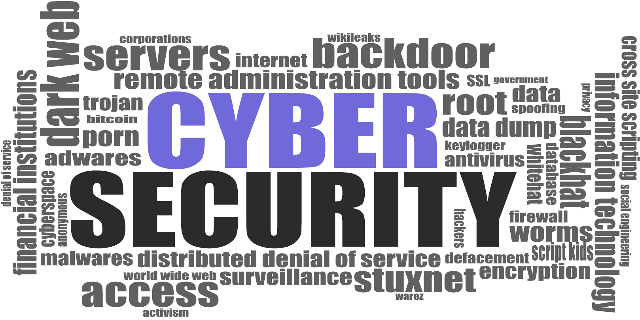In the digital landscape of the modern age, the pertinence of cybersecurity cannot be overstated. As technology advances, so do the methods employed by cyber threats, making it essential for individuals and businesses alike to comprehend the significance of robust online security. From protecting sensitive data to safeguarding financial assets, understanding the intricacies of cybersecurity is paramount in today's interconnected world.
With cyber attacks on the rise, it's crucial for individuals and organizations to stay ahead of potential threats. This article will delve into the vital aspects of cybersecurity, decoding its importance in mitigating risks and fortifying online defenses. By unraveling the complexities of cybersecurity, we aim to provide insight that empowers readers to navigate the digital realm with confidence and transparency.
As we navigate this virtual realm, the keystones of cybersecurity extend far beyond mere protection – they encompass the assurance of trust, integrity, and privacy. Join us as we uncover the fundamental aspects of cybersecurity and equip ourselves with the knowledge to combat emerging digital threats, ensuring a secure and resilient online environment.
The Importance of Cyber Security
Cybersecurity is crucial in safeguarding sensitive information and ensuring the integrity and privacy of data. It plays a pivotal role in protecting individuals, businesses, and government entities from a wide range of cyber threats. A robust cybersecurity framework is essential to prevent unauthorized access, data breaches, and financial fraud, ultimately preserving trust and confidence in the digital ecosystem.
In today's hyper-connected world, the importance of cybersecurity cannot be understated. With the increasing reliance on digital platforms for communication, commerce, and information exchange, the potential risks associated with cyber threats have also amplified. Cybersecurity serves as a shield against these threats, fortifying the digital infrastructure and mitigating the vulnerabilities that can be exploited by malicious actors.
The significance of cybersecurity is further accentuated by its role in upholding national security and continuity of critical services. As cyber attacks continue to evolve in sophistication and scale, the resilience of cybersecurity measures becomes paramount in safeguarding essential infrastructure, such as energy grids, transportation systems, and financial institutions, from potential disruption and compromise.
Common Cyber Security Threats
Cybersecurity threats come in various forms, each posing unique risks to individuals and organizations. Common threats include malware, ransomware, phishing attacks, and social engineering tactics. Malware, a collective term for malicious software, is designed to infiltrate systems, steal data, or cause damage to digital assets. Ransomware, on the other hand, encrypts data and demands a ransom for its release, posing a significant threat to businesses and individuals alike.
Phishing attacks, often initiated through deceptive emails or fraudulent websites, aim to trick users into divulging sensitive information such as login credentials or financial details. Social engineering tactics involve manipulating individuals into divulging confidential information through psychological manipulation or impersonation. These threats underscore the need for robust cybersecurity measures to counteract and neutralize potential risks.
Cybersecurity threats are not limited to specific industries or sectors; they can impact anyone with an online presence. Understanding these threats is the first step in devising effective strategies to mitigate their impact and prevent potential breaches or data compromises. By staying informed about common cyber threats, individuals and organizations can proactively implement measures to enhance their security posture and protect against evolving digital risks.
Cyber Security Statistics
The prevalence of cyber threats is reflected in alarming statistics that highlight the widespread impact of cyber attacks. According to a recent study, cybercrime is estimated to cost the global economy over $1 trillion, underscoring the financial ramifications of inadequate cybersecurity measures. Furthermore, data breaches and cyber attacks have become more frequent, with a significant increase in the number of reported incidents across various industries.
The healthcare sector, in particular, has experienced a surge in cyber attacks, with an estimated 28% increase in data breaches over the past year. These statistics underscore the urgency of bolstering cybersecurity defenses, especially in sectors that handle sensitive personal and medical information. Additionally, the proliferation of remote work and digital transactions has expanded the attack surface for cybercriminals, necessitating heightened vigilance and proactive security measures.
Cybersecurity statistics also reveal the growing sophistication of cyber threats, with an increase in targeted attacks and the use of advanced persistent threats (APTs) by state-sponsored actors and organized cybercrime groups. These trends emphasize the need for continuous innovation and adaptation in cybersecurity strategies to effectively thwart and neutralize emerging threats.
Cyber Security Best Practices
Implementing cyber security best practices is essential for mitigating risks and fortifying defenses against potential threats. Regular software updates and patch management play a crucial role in addressing vulnerabilities and strengthening the resilience of digital systems. By promptly applying security patches and updates, individuals and organizations can mitigate the risk of exploitation by known security flaws.
Strong password management is another fundamental best practice in cybersecurity. Encouraging the use of complex, unique passwords and implementing multi-factor authentication can significantly enhance the security of online accounts and systems. Additionally, conducting regular security awareness training for employees and users can foster a culture of vigilance and empower individuals to recognize and respond to potential security threats effectively.
Encryption is a cornerstone of cybersecurity best practices, enabling the secure transmission and storage of sensitive data. By encrypting data at rest and in transit, organizations can safeguard confidential information from unauthorized access and interception. Furthermore, establishing robust incident response and disaster recovery plans can minimize the impact of potential security incidents and facilitate swift recovery in the event of a breach or cyber attack.
Understanding Encryption and Data Protection
Encryption plays a pivotal role in safeguarding sensitive data and ensuring privacy and confidentiality in digital communications. By converting plaintext information into ciphertext using cryptographic algorithms, encryption renders data indecipherable to unauthorized parties. This process of encoding and decoding data provides a secure means of transmitting and storing sensitive information, mitigating the risk of unauthorized access or interception.
Data protection encompasses a broader spectrum of strategies and technologies aimed at preserving the integrity, availability, and privacy of digital data. This includes measures such as access controls, data masking, and secure data storage practices. By implementing robust data protection mechanisms, organizations can fortify their defenses against data breaches and unauthorized disclosures, thereby fostering trust and confidence in their data handling practices.
Understanding encryption and data protection is essential for individuals and organizations seeking to establish a secure digital environment. By leveraging encryption technologies and implementing comprehensive data protection strategies, entities can mitigate the risk of data compromise and uphold the confidentiality and integrity of sensitive information, thereby fostering a secure and resilient digital ecosystem.
Cyber Security for Businesses
For businesses, cybersecurity is a critical component of risk management and operational resilience. A robust cybersecurity framework is essential to protect sensitive business data, intellectual property, and customer information from potential breaches and unauthorized access. In addition to safeguarding digital assets, cybersecurity also plays a pivotal role in preserving the reputation and trust of the organization in the eyes of its stakeholders and customers.
Compliance with regulatory requirements and industry standards is another key aspect of cybersecurity for businesses. Many sectors have specific data protection and security mandates that necessitate adherence to prescribed cybersecurity practices and standards. Failure to comply with these regulations can result in severe penalties and legal repercussions, making cybersecurity an indispensable aspect of corporate governance and compliance.
Investing in cybersecurity technologies and solutions is paramount for businesses seeking to fortify their defenses against cyber threats. This includes deploying advanced endpoint protection, intrusion detection systems, and security information and event management (SIEM) solutions to detect and mitigate potential security incidents. Additionally, conducting regular security assessments and penetration testing can identify and address vulnerabilities proactively, enhancing the overall security posture of the organization.
Cyber Security for Individuals
Individuals also play a critical role in ensuring their own cybersecurity and protecting their personal information from potential threats. Practicing good cyber hygiene, such as regularly updating software and using strong, unique passwords, is essential for mitigating the risk of falling victim to cyber attacks. Additionally, exercising caution when clicking on links or downloading attachments from unknown sources can prevent malware infections and phishing attempts.
Educating oneself about common cyber threats and staying informed about the latest security best practices can empower individuals to make informed decisions about their online security. This includes being vigilant about sharing personal information online and exercising discretion when interacting with unknown entities or websites. By adopting a proactive approach to personal cybersecurity, individuals can minimize the risk of falling victim to cybercrime and unauthorized data access.
Furthermore, leveraging security tools such as antivirus software, firewalls, and virtual private networks (VPNs) can add an additional layer of protection to personal devices and online activities. These tools can help detect and mitigate potential threats, providing individuals with enhanced security and peace of mind while navigating the digital landscape.
Cyber Security Certifications and Training
Obtaining cyber security certifications and undergoing specialized training can equip individuals with the knowledge and expertise to navigate the complexities of cybersecurity effectively. Certifications such as Certified Information Systems Security Professional (CISSP), Certified Ethical Hacker (CEH), and CompTIA Security+ are highly regarded in the cybersecurity industry and validate proficiency in various aspects of cybersecurity, including risk management, network security, and ethical hacking.
Specialized training programs and workshops also provide valuable insights into emerging cyber threats, advanced security technologies, and best practices for implementing robust cybersecurity measures. By investing in continuous learning and professional development, individuals can enhance their skill set and contribute to the resilience of digital security frameworks, both at the organizational and individual levels.
Cybersecurity certifications and training not only enhance individual capabilities but also contribute to the overall maturity and preparedness of organizations in addressing cybersecurity challenges. By fostering a workforce with specialized cybersecurity expertise, businesses can bolster their defenses and proactively mitigate potential risks, ultimately contributing to a more secure and resilient digital ecosystem.
Cyber Security Tools and Software
The landscape of cybersecurity tools and software encompasses a diverse array of solutions designed to address specific security challenges and mitigate potential threats. Antivirus and anti-malware software form the foundation of digital security, providing essential protection against a wide range of malicious software and potential vulnerabilities. These tools scan and detect threats, ensuring the integrity of digital systems and data.
Firewalls are another critical component of cybersecurity, serving as a barrier between internal networks and external threats. They monitor and control incoming and outgoing network traffic based on predetermined security rules, preventing unauthorized access and potential attacks. Intrusion detection and prevention systems (IDPS) complement firewalls by identifying and mitigating potential intrusions and security breaches in real-time.
Security information and event management (SIEM) solutions play a pivotal role in aggregating and analyzing security data from various sources, enabling organizations to detect and respond to potential security incidents effectively. These solutions provide comprehensive visibility into the security posture of digital environments, facilitating proactive threat detection and incident response. Additionally, endpoint protection solutions and secure email gateways offer targeted security measures to mitigate the risk of malware infections and phishing attempts.
Conclusion
In conclusion, cybersecurity is an indispensable pillar of the modern digital landscape, encompassing vital aspects such as risk mitigation, data protection, and resilience against evolving cyber threats. By understanding the importance of cybersecurity, individuals and organizations can proactively fortify their defenses and navigate the digital realm with confidence and security. From implementing best practices to leveraging advanced security technologies, the journey towards robust cybersecurity requires continuous vigilance, education, and adaptation to combat emerging threats effectively.
As we continue to navigate the interconnected digital ecosystem, the significance of cybersecurity in preserving trust, privacy, and integrity cannot be overstated. By embracing a proactive approach to cybersecurity and staying informed about the latest advancements in digital security, we can collectively contribute to a secure and resilient online environment, safeguarding critical assets and upholding the principles of privacy and confidentiality in the digital age. Cracking the code of cybersecurity is not merely a pursuit of protection; it is a commitment to fostering a digital landscape built on trust, resilience, and empowerment. Let us embark on this journey together, fortifying our digital defenses and shaping a secure future in the modern age.


